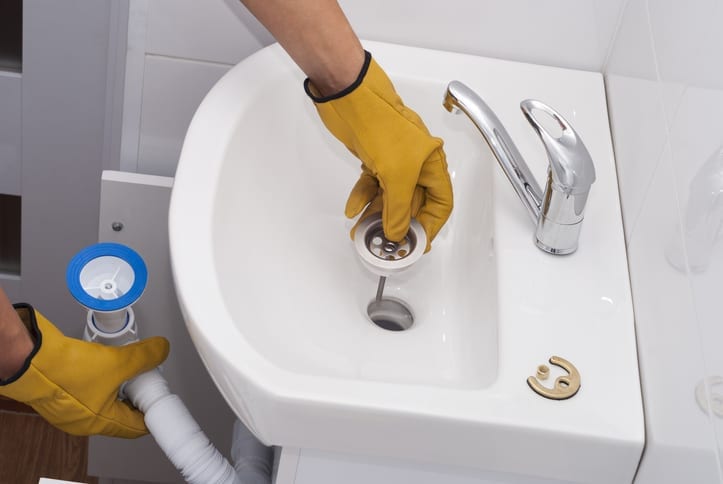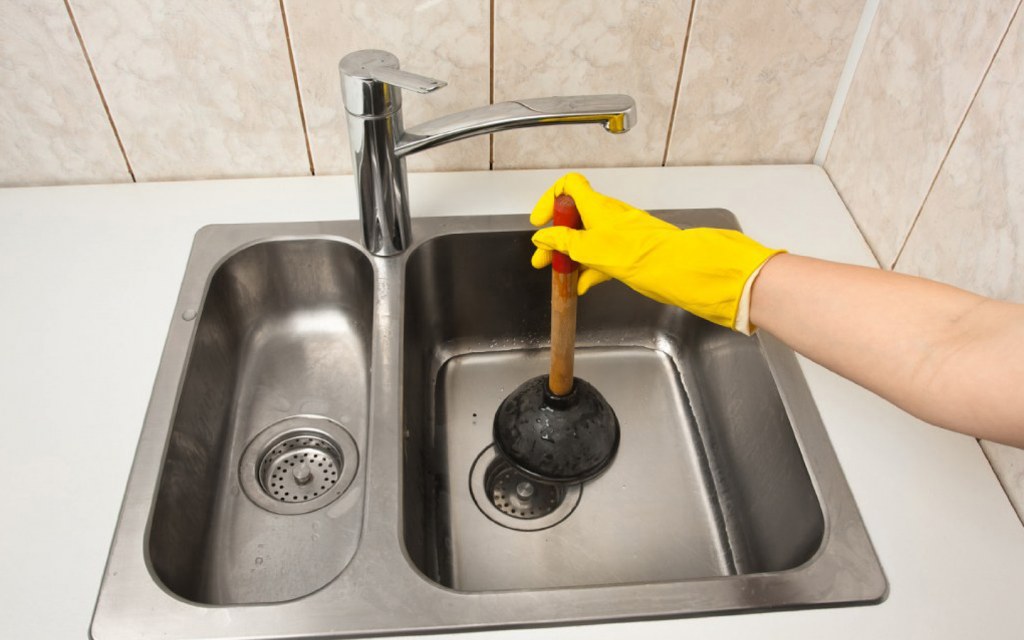Figuring Out Why Your Kitchen Sink Won’t Empty Properly: Six Causes
Figuring Out Why Your Kitchen Sink Won’t Empty Properly: Six Causes
Blog Article
Just about everyone will have his or her own assumption when it comes to Why Is My Sink Not Draining?.

It's not regular for your kitchen sink to clog up numerous times in one month. If your sink obstructs two times a week, there's some trouble going on.
An obstructed cooking area drainpipe does not just decrease your tasks, it deteriorates your whole plumbing system, gradually. Below are some common practices that encourage sink blockages, and how to avoid them.
You require appropriate waste disposal
Reusing waste is wonderful, however do you take notice of your natural waste as well? Your kitchen area must have 2 different waste boxes; one for recyclable plastics and also one more for natural waste, which can come to be compost.
Having actually a marked trash can will help you and your family stay clear of throwing pasta as well as various other food residues away. Typically, these residues take in moisture and also become clogs.
A person attempted to clean their hair in the kitchen sink
There's a right time and also location for whatever. The cooking area sink is just not the ideal location to clean your hair. Washing your hair in the cooking area sink will certainly make it clog sooner or later unless you use a drain catcher.
While a drainpipe catcher might catch a lot of the fallouts, some hairs may still get through. If you have thick hair, this may be enough to reduce your drainage and at some point create an obstruction.
You're throwing coffee down the tubes
Made use of coffee premises and coffee beans still absorb a significant quantity of wetness. They may appear tiny adequate to throw down the drainpipe, but as time takes place they begin to swell and also take up even more space.
Your coffee premises should enter into organic garbage disposal. Whatever fraction runs away (possibly while you're depleting) will certainly be dealt with during your monthly clean-up.
Youhave actually been eating a great deal of greasy foods
Your kitchen area sink might still get obstructed even with organic garbage disposal. This might be because you have a diet plan abundant in greasy foods like cheeseburgers.
This oil layers the insides of pipes, making them narrower and also more clog-prone.
Your pipe had not been repaired appropriately to begin with
If you've been doing none of the above, however still obtain regular clogs in your kitchen area sink, you should certainly call a plumber. There might be an issue with just how your pipelines were installed.
While your plumber shows up, look for any kind of leaks or abnormalities around your cooking area pipelines. Don't attempt to take care of the pipelines on your own. This may cause a mishap or a cooking area flooding.
There's even more dust than your pipes can deal with
If you get fruits directly from a farm, you may observe even more cooking area dust than other individuals that go shopping from a shopping mall. You can easily fix this by cleaning the fruits as well as veggies appropriately prior to bringing them right into your house.
Thaw the sludge
The fault isn't from your kitchen sink whatsoever
Maybe the problem isn't from your kitchen sink, but the entire drain system. In such an instance, you may observe that sinks as well as drains get obstructed every other week. You require an expert plumbing solution to fix this.
What to Do When Your Kitchen Sink Won t Drain
Many of us have experienced something like this: one minute you are washing a pile of dirty dishes, and the next you hear a strange gurgling sound coming from the mechanical depths of your kitchen sink. The water is staying put, perhaps even changing colour and starting to rise; suddenly the soundtrack to Jaws is playing, and you realize you are dealing with a clogged sink! Usually, you have to act quickly, but don t panic just yet. Non-toxic home remedies and DIY solutions can do the trick, so before you call a plumber, read on to find out what you can do when your kitchen sink won t drain.
What Causes Your Sink to Clog?
It s great to know how to properly care for your kitchen sink so you can keep your drain and pipes running smoothly. For instance, some foods and products should never be washed down your drain, like grease, oil, and coffee grounds. Why? Grease and oil will eventually congeal at cold temperatures, and coffee grounds clump together when they harden. If you run hot water down your drain to flush them out, they will still cause trouble further down your pipe.
Dumping foods like meat, fibrous fruits and veggies like celery or banana peels, and starches such as noodles, rice and potatoes down your drain is also a big no, even if you have a garbage disposal. Food trapped in your disposer is a common problem, often leading to a blocked drain, so be sure not to overload it. Instead, put all your food scraps in your compost or green bin. Think of your drain as a major artery: you don t want to clog it by putting harmful food and waste down your sink which can build up over time and cause problems.
Popular Home Remedies: What You ll Need
Drain cleaners like Liquid Plumr or Drano often contain chemicals that are corrosive and harmful to the environment, so it s best not to use them. Instead, try using natural remedies and the following life hacks to remove any debris. You ll need to have the following items handy: rubber gloves (if you don t want to dirty your hands), baking soda, salt, vinegar/lemons (or lots of lemon juice), a coat hanger, a plunger, a mug or container for scooping water, and some large buckets. You can also purchase a gadget called a Zip-It, which is an alternative to using a coat hanger. Ideally, you will already have many of these household items lying around, but a quick trip to a supermarket or dollar store should do the trick.
Boiling Water Techniques
The first thing you ll need to do is remove everything from your sink (dishes, sponges, etc.) and start bailing out the excess water into a bucket. Once it is as empty as possible, and no water is filling back up into your sink, bring a kettle of water to a boil and dump its entire contents down the drain. Hot water can often loosen particles and clear a pathway.
If nothing happens after a few minutes, bail the water out and try again. If this is unsuccessful after a few attempts, pour half a cup of salt down your drain, followed by more boiling water. Wait for a few minutes to see if the water level starts to lower. Again, if nothing happens, you can try again, or try a new approach.
Baking Soda Techniques
Same as before, remove all water from your sink. Pour half a cup of baking soda followed by half a cup of white vinegar or lemon juice down your drain, and once the solution stops fizzing, cover with a stopper or a wet dish towel for about 15 minutes. Run hot water down the drain to check if the blockage is gone. You may need to repeat this a few times to clear the mess.
Alternatively, mix half a cup of salt with one cup of baking soda (do not add water), but for best results, you must let this sit for a few hours or overnight. Test it out after by pouring a pot of boiling hot water down the drain.
Go Fish: Coat Hanger or Zip-It Technique
If your sink is still causing you grief, unbend a wire coat hanger into a straight line with a hook, or use a Zip-It to fish out the clog. An alternative to properly snaking your drain, insert either of these tools down your drain until you encounter any resistance, and clear the clog by pulling it up. No luck? The clog might be further down.
Take the Plunge
If these previous techniques don t work, a little bit of elbow grease may be required. For homeowners with a garbage disposal, always unplug it before plunging and check for any clogs inside. If you have a dishwasher, use a clamp to seal off the drain line you don t want any dirty water flowing back into your appliance! Once you have done that, you are ready to plunge. Fill the clogged sink with enough water so the rubber part is sealed tightly around your drain, and work the plunger until you feel something dislodge. It may take a few minutes of plunging for water to start flowing normally down the drain.
https://blog.homestars.com/what-to-do-when-your-kitchen-sink-wont-drain/

I am very occupied with Five Ways to Fix a Slow Sink Drain and I am assuming you enjoyed our blog post. Are you aware of somebody else who is sincerely interested in the subject? Feel free to promote it. Thanks so much for your time spent reading it.
Immediate care? Call! Report this page